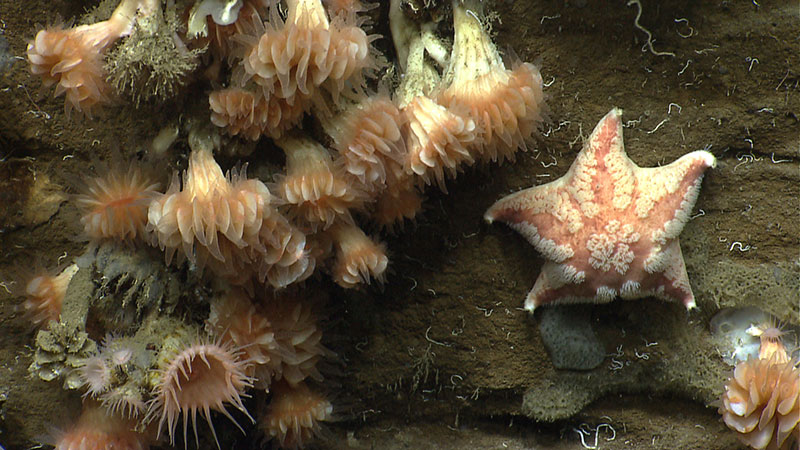
Cup corals and a sea star a mile underwater in Heezen Canyon. Image courtesy of the NOAA Office of Ocean Exploration and Research, Northeast U.S. Canyons Expedition 2013. Download larger version (jpg, 1.4 MB).

Cup corals and a sea star a mile underwater in Heezen Canyon. Image courtesy of the NOAA Office of Ocean Exploration and Research, Northeast U.S. Canyons Expedition 2013. Download larger version (jpg, 1.4 MB).
Today’s dive was along a deep section on the southwestern flank of Heezen Canyon. The remotely operated vehicle (ROV) was on bottom at 1,710 meters. For the initial part of the dive, the seafloor was composed of soft sediment with scattered rocks of various sizes and colors. Mudstone slabs, glacial erratics (igneous rock) and granite were among the rocks observed at the base of the slope. One large block was likely dislodged from close by, given that it was relatively intact with little debris nearby. Several fauna were attached to the rocks, including anemones, brisingid seastars, white holothurians, and Anthomastus, including several small recruits. On the sediment surface, several xenophyophores, brittle stars, few sea pens, sea urchins, and a sea spider were present. Several fish were observed during the dive. Trash was noted throughout the dive, particularly at the base of the main wall, including line and plastic material. As the ROV ascended the rock wall, the rock face was extensively fractured and had several horizontal striations with multiple holes. The dive track moved upslope along very steep features, sometimes > 90 degrees. The ROV continued upslope to the top of the steepest feature, transited shortly on a long sediment ledge, then was redirected downslope to the steepest feature in the area. The sedimented ledges that were present at the base and top of the slope were often colonized by deepwater coral, pale brittle stars, and xenophyophores. As the ROV transited up slope a second time, and moved laterally to the northwest, a few encrusting fauna dominated the rock assemblages, including brisingid sea stars, cup corals (cf. Desmophyllum), sponges, and anemones. Abundances of these taxa were patchy throughout, with some rock surfaces heavily encrusted while other had very few. Other corals observed in low abundance including the Bathypathes-like and Stichopathes (black corals), Acanella (bamboo, one with roots visible), Umbellula (sea pen), Acanthogorgia and Radicipes (octocorals), Solenosmilia (colonial hard coral), Clavularia (stoloniferan). On two occasions, a zoanthid mat carpeting rock surfaces was noted living adjacent to cup corals and anemones. A few other sea star species were observed clinging to the rock faces and laying on the sediment surface. Other notable observations during the dive included active predation when a squid was seen eating a fish, chaetonatha (arrow worms) floating in the water column, caprellid amphipods, a purple and pink polychaete laying on the sediment surface, and the retracting proboscis of an echiuran. Periodically, the ROV came upon rock faces that appeared recently exposed, with a smooth surface. In addition, there was evidence of high current flow in certain areas where ripple bed forms were clearly visible in the sediment surface. The dive ended at 1937 UTC at a depth of 1,621 meters.